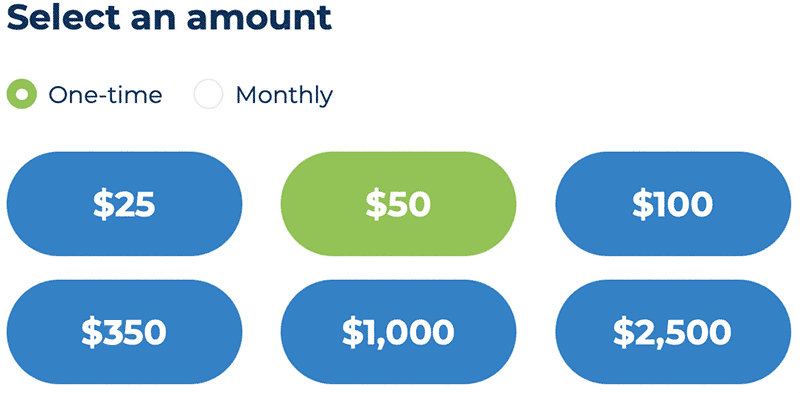How much clean energy does California need to be 100% carbon free by 2045, and are we on track to meet that need?
Contents:
I. Introduction–Power vs Energy
II. What is Clean Energy?
III. How much Energy is Needed?
IV. How much Power is Needed?
V. Global Perspective–a look at China
VI. Policy implications
I. Power vs. Energy
350 Bay Area is building a grassroots climate movement. . . to achieve a clean energy future. . . This means that climate activists should understand what clean energy is, how we measure it, and how much we need. Knowing these facts gives us the basis for holding elected officials and government agencies accountable.
This paper attempts to answer these questions to equip all climate activists in the Bay Area and beyond to avoid confusion, misunderstandings, and misdirection. For example, often a press release will say something like “Offshore wind is planned to provide 20 Gigawatts of power by 2040”. But what does this mean–is it significant? How does it fit into the overall context? Hopefully this paper will help clarify these types of questions.
One source of confusion (for me at least) with electricity discussions is the difference between power and energy.
Power is measured in watts, kilowatts (KW = 103 watts), megawatts (MW = 106 watts), and gigawatts (GW = 109 watts)
Energy is measured in kilowatt hours (kWh = 103 watt-hours), megawatt hours (MWH = 106 watt hours), gigawatt hours (GWH = 109 watt hours) and terawatt hours (TWH = 1012 watt hours).
The two are related:
Energy = Power x Time (e.g 1000 watts x 1 hour = 1 kilowatt hour)
But Power and Energy pose somewhat different problems as we shall see.
II. What is Clean Energy?
First we need to define our terms. Our goal is clean energy, but what do we mean by that? The state’s goal is actually “carbon free” or “zero carbon” energy.
Zero carbon often includes nuclear, but this paper does not, since nuclear does have a carbon footprint in its mining for uranium, and more importantly, has unsolved environmental impacts as exemplified by disasters at Chernobyl and Fukushima, plus the issue of where to store radioactive wastes. Also, California has plans to phase out its one nuclear plant by 2030, so we shouldn’t count on nuclear as a power supply.
Similarly, biomass is counted as a renewable source of energy by the State of California, since burning wood or other biomass returns CO2 to the atmosphere that was captured by the wood in photosynthesis–i.e. net zero. But leaving the wood or other biomass in place would result in a much slower release, with much less pollution, and with favorable as opposed to destructive ecological impacts. Where dead trees do need to be removed, e.g. in wildland-urban interfaces, a better solution is to convert the trees to biochar, not burn them for energy. So this paper does not count biomass as zero carbon or renewable.
On the other hand, large hydro is also not counted as renewable in California. This is appropriate and the state should not build additional large hydro plants without serious environmental review. However, large hydro is in fact zero carbon, and it is unlikely that California will be removing many dams soon, so large hydro is included in the calculations toward California’s goal of zero carbon energy by 2045 in this paper. Hopefully, in the future as we continue to increase renewable energy, and find ways to store water, e.g. in aquifers, we can plan the removal of large dams.
To be specific then, for the purposes of this paper, zero carbon, or “clean” energy includes solar, wind, geothermal, and large and small hydro. All of these sources except large hydro are considered to be renewable. Since large hydro is not expected to increase much if at all in the next 20 years, essentially all of the growth in energy will need to come from renewable sources.
No doubt this definition can be debated, but I want to make sure that we are clear on how the terms are being used for the purposes of this paper.
III. How much Energy is Needed?
Senate Bill 100 (2018) requires 100 percent of California’s electric retail sales be supplied by renewable and zero-carbon energy sources by 2045. SB 1020 (2022), established interim targets of 90 percent clean electricity by 2035 and 95 percent by 2040. The challenge is to meet these goals.
Unfortunately, the current rate of installation of new renewable energy generation sources is well below the state’s required pace.
Table 1 (source – California Energy Commission) shows that the state is not on track to meet its targets. The Table shows that the state produced 203 TWH of electricity in 2022 of which 83 TWH (83,153 gWh, about 41%) was zero-carbon.
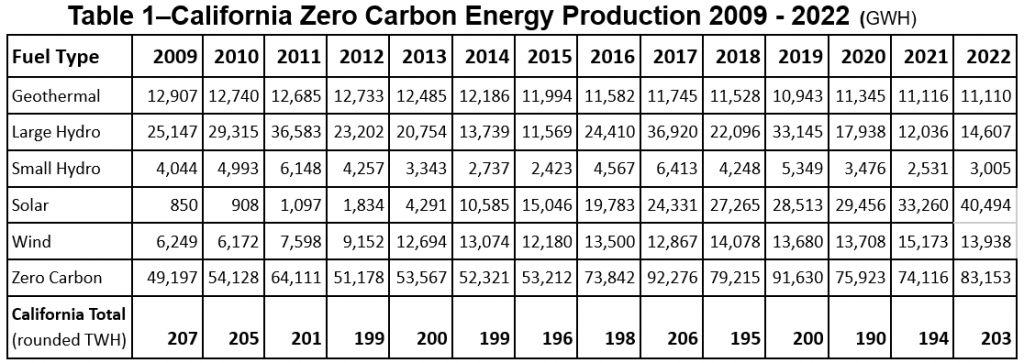
Table 1 shows that zero carbon energy produced in California rose from 49 TWH in 2009 to 83 TWH in 2022. At this rate–2.4 TWH increase per year–California would reach about 140 TWH by 2040, which would only be 70% of the state’s current energy total. This slow rate of increase is shown in Figure 1.
Figure 1
But the reality is even more challenging than the current figures suggest. With the growth in EVs and building electrification, total energy needed in California will grow substantially, which means that energy production will need to increase faster just to keep up. We will discuss this in detail below.
Looking at California’s total energy picture–including imports (source)–the numbers in Table 2 show that 43% of California’s total energy of 287 TWH was zero carbon in 2022. The state imported 84 TWH of electricity1 of which 40 TWH was zero carbon2.
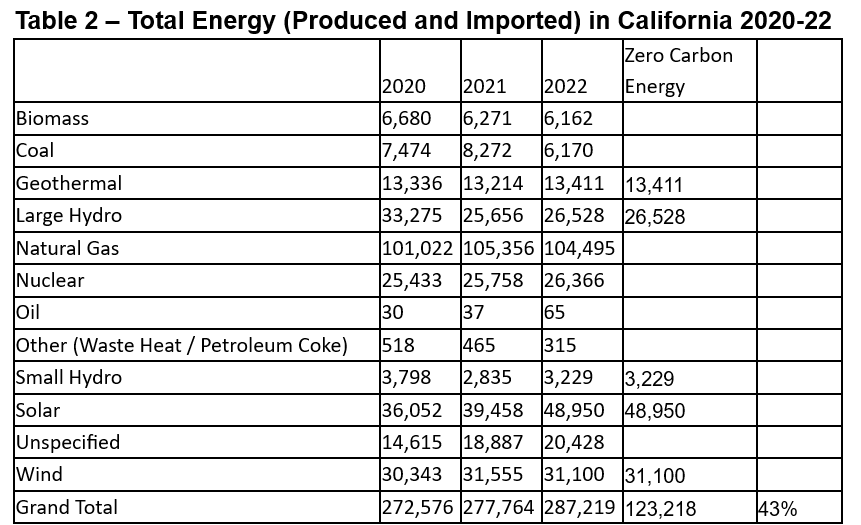
1 Computed from Table 2 – Table 1: 287 TWH – 203 TWH = 84 TWH
2 Computed using Table 2–123 TWH total zero carbon – total minus Table 1–83 TWH CA zero carbon
These tables do not include rooftop solar, which produced 23 TWH in 2022 according to Wikipedia. This could lead us to a long discussion about why rooftop solar is not incorporated more closely into the State’s energy planning, but this is beyond the scope of this paper. I am working on a separate paper to discuss the attacks on rooftop solar, and why we need to combat them.
How much additional clean energy do we need?
As noted, an important factor is the growth of EVs (cars, trucks & buses) and heat pumps. My calculation estimates about a 90% growth by 2045. This is very close to the San Diego Gas & Electric estimate of 96% growth. The California Independent Service Operators, (CAISO) estimates that “the amount of electricity projected to be needed two decades from now is almost three times what the grid has today.” CAISO doesn’t say how they got that number, so I’m inclined to think it’s too high. But I will round my number up to estimate that we will need 2.0 times the current energy by 2045, i.e. 100% growth.
Based on this, the state will need 287 TWH (from Table 2) x 2.0 = 574 TWH by 2045. If we maintain the same percentage of imports (29%), then 574 x .29 = 167 TWH would be imported and 407 TWH would be produced in California. The state currently produces 83 TWH of zero carbon electricity, and would need to expand this to 407 TWH, an increase of 324 TWH, or a factor of almost 5, with a similar increase for imported clean electricity.
This added energy will have to be mostly from wind and solar backed by storage since it is unlikely that geothermal or hydro (large or small) will increase significantly.
To sum up, to achieve 100% clean energy by 2045 California need to:
- Continue to produce 83 TWH with water, wind, sun, and geothermal
- Replace the remainder of the 203 TWH non-zero carbon energy that we currently produce with wind and solar–203 – 83 = 120 TWH
- Double the amount of clean electricity, i.e. add 203 TWH
Total clean energy needed = 83 + 120 + 203 = 407 TWH (rounded)
These numbers all point to the need to accelerate installation of wind and solar as rapidly as possible. At the growth rate shown in Figure 1 we would only reach 141 TWH by 2045–i.e. way below 407 TWH needed!
To understand how much power we need to add to generate this much energy, we need to look at the Power side of the picture.
IV. How much Power is Needed?
Since Energy = Power x Time, then Power = Energy divided by Time. So if we know how much energy we need in a year, we can divide that by the number of hours in a year to convert to power needed.
When we divide 407 TWH by 8760 hours per year, we get 46 GW of power on average will be needed.
But it’s not quite that simple.
There are at least two issues that complicate the power picture–the capacity factor and the peak hour problem.
Capacity Factor
We can’t count on the power actually supplied to the grid to be at 100% of capacity. This means that we need to provide more power capacity to meet actual power demands. How much more capacity do we need?
Wind and solar are intermittent sources. Figure 2 below (Source) shows their capacity factor–defined as the % of capacity that they actually produce compared to their theoretical capacity–to be about 30%.
Figure 2
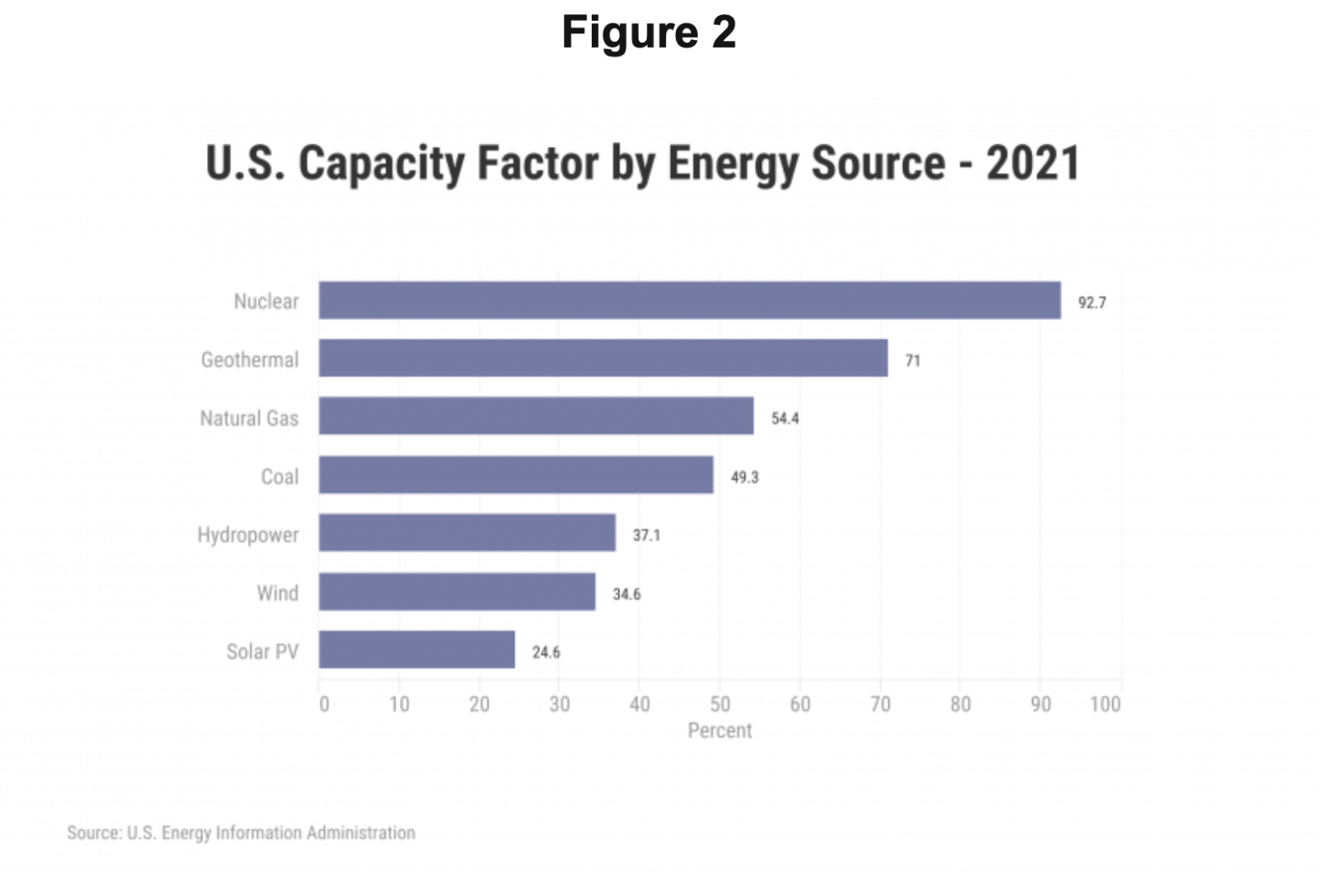
This means that to generate a total of 46 GW of power, we need 46 GW divided by .30 = 153 GW of capacity. We should also add 10% for power losses in transmission. This gives us about 168 GW of capacity needed.
Figure 3 from May 2023’s Building The Electricity Grid Of The Future: California’s Clean Energy Transition Plan suggests that California needs to reach 183,000 MW (183 GW) by 2045.
Figure 3
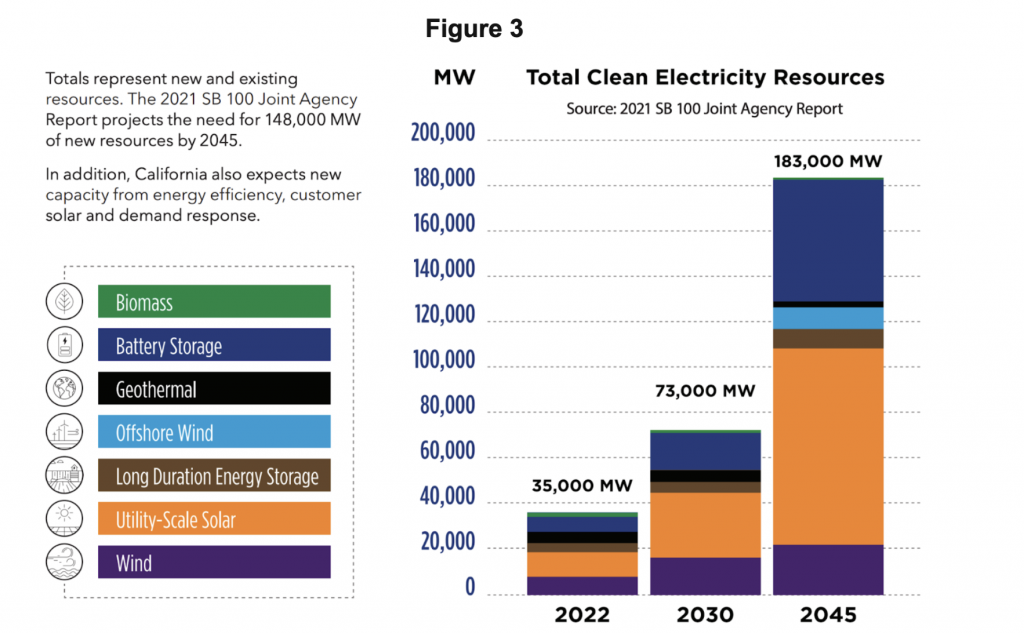
Note that Figure 3 counts storage as a source of energy. Most of this is short term–4 hours of power per day. To create the storage requires added wind or solar, so the total of 183 GW projected in Figure 3 is not too far from my estimate of 168 GW needed.
These numbers now give us the ability to understand what is meant by the statement, “California will add 20GW of offshore wind by 2040.” Offshore wind is represented by the light blue portion of the 2045 graph in Figure 3. We can understand that 20GW of offshore wind power would be a valuable, but still small part of the overall power needed.
We still don’t know how much energy the 20 GW will generate without knowing the capacity factor. This article from the National Renewable Energy Labs puts the capacity factor for offshore wind around 45%. So we can calculate 20 GW x 8760 hours x .45 = 79 TWH. We estimated above that California will need to produce 407 TWH, so offshore wind could provide 19% of the total–not bad! Unfortunately there are lots of technical issues with developing offshore wind, so achieving California’s goal is not a simple matter.
The Peak Hour Problem
Not only do we need to adjust power for the capacity factor, but we also can’t count on the grid’s power demand to be constant, i.e. we have to plan for the peak periods.
This problem is known as the “duck curve” as shown in Figure 4 below (source):
Figure 4–The Duck Curve in California

The curves in Figure 4 show that, as solar power production has increased in the years 2012- 2019, the demand for power from other sources during the day has dropped. This creates a PM peak of power demand (the head of the duck), especially in the summer, but persistently throughout the year. The problem is that the grid needs to be built to meet that peak demand to avoid power blackouts. It also needs to supply power at night as well as the day. As shown in the figures, the power demand on the grid normally doesn’t go above 30 – 35 GW, so it would seem that a grid with 35 GW of power would be sufficient. But for a few hours a year the demand can shoot up to over 50 GW.
This means that power sources may need to provide around 15 GW above the average load to make sure there are no power shortages. Clearly this is an expensive added cost.
The utilities have built methane gas “peaker plants” to address the peak hour problem. California has peaker plants that can produce about 16 GW of power when needed.
There are several alternate ways to solve the peak hour problem. One is to shift the demand from the PM peak to the daytime by Time-of-Use (TOU) electricity rates. Related to this are Demand Response programs to further incentivize customers to reduce use in the PM peak. The state legislature has set a goal of 7 GW of Demand Response. 350 Bay Area is proposing a bill that would codify the legislature’s call for Demand Response and increase the target to 15 GW.
Another approach is to encourage battery storage so that excess solar built up during the day can be used for the PM peak. If the batteries are “Long Duration”–e.g. 10 hours or so, they can also serve overnight power demands.
California now has over 6 GW of battery storage–up from less than 1 GW in 2020– plus about 10 GW of hydro storage that can be used in peak periods. Figure 5 below shows the rapid growth of batteries.
Figure 5–Growth of Batteries in California
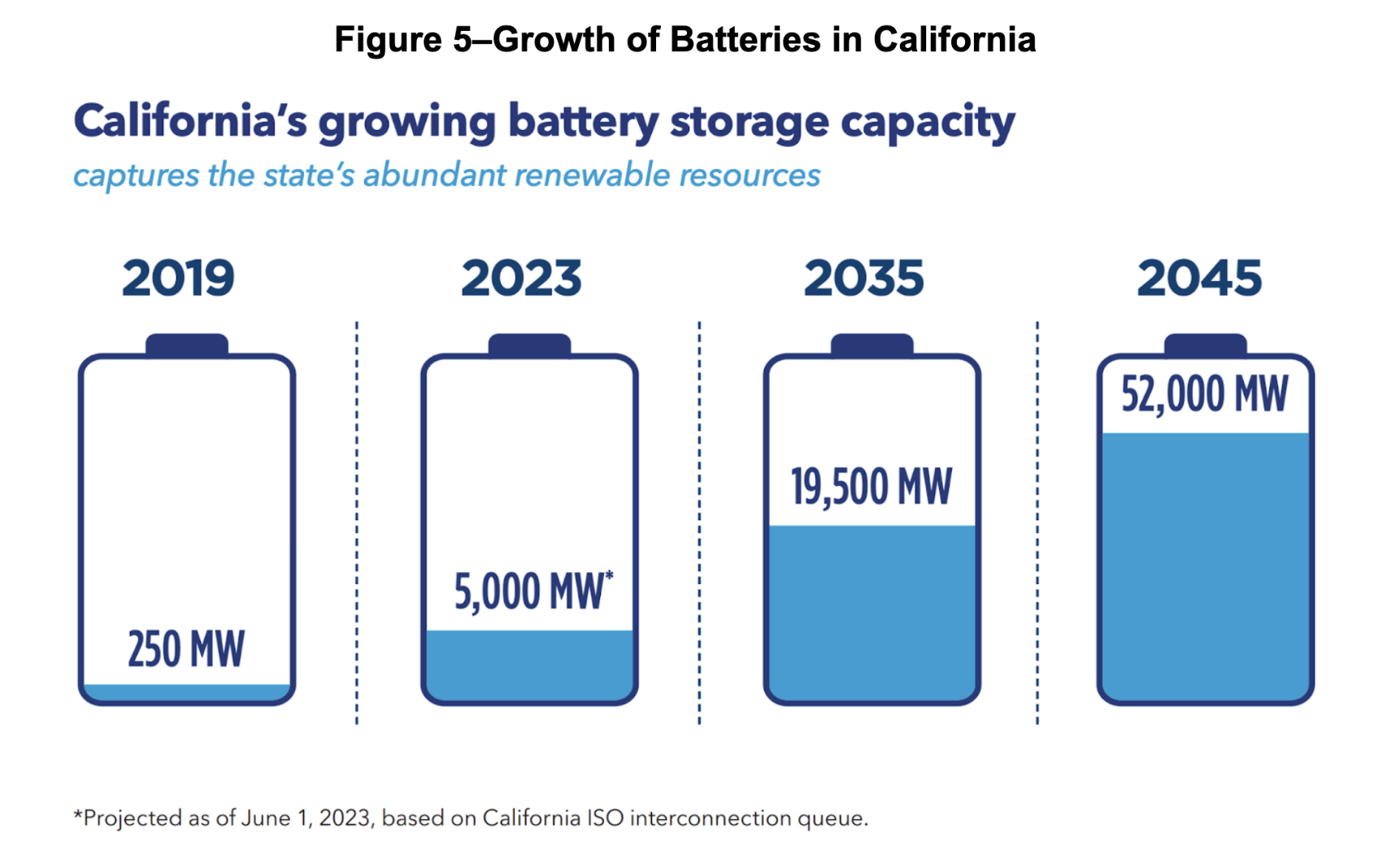
As noted, this storage is designed only for about 4 hours, aiming to flatten the PM peak; this gives it a capacity factor of 4/24 = .16. This means that 52,000 MW of storage can provide about only about 7 TWH of energy. (52 GW x 8760 hours x .16) In other words, a lot more storage will be needed to replace all the methane gas plants, which provide energy overnight.
This is further illustrated in Figure 6 from Peninsula Clean Energy (PCE), which shows how achieving 100% annual renewable energy–i.e. the total renewable energy generated equals the total demand—still leaves gaps at night, especially in the fall and winter, when additional power is needed. (source)
The PCE report also says, “Seasonal storage could help to reduce excess supply, but no cost-effective seasonal storage is yet available.” This is illustrated in Figure 6, which shows a big excess of energy in the summer, and a shortfall in the winter. If we add more solar, we end up with even more excess in the summer. This is where offshore wind could be very valuable, since the wind is strong at night, and year round. It’s also possible that clean hydrogen, made from water, could be stored from summer to winter.1
Figure 6–Peninsula Clean Energy Model of 100% Clean Energy

1 Note that PCE’s 100% annual clean energy, while not ideal, still emits about 50% fewer GHGs than the state average–101 g/kWh for PCE vs. 207 g/kWh state average, and about 75% below the US average of 390 g/KWH. And PCE is aiming for 24/7 clean energy–see their report for details.
The California Energy Commission predicts that peak power needs will grow from 62 to 75 GW in 2035 (see tab Form 1.4–”Final Net Peak”, high use scenario). This is a power, can deliver about 45GW, not counting peaker plants; it it grows toward the 168 GW that I’m estimating it will need in 2045, it will add about 5 GW per year of new wind and solar. If this is combined with storage, including vehicle to grid, and demand management, the peak hour should be more than covered in future years.
However, as argued, while achieving 168 GW would mean that we won’t require peaker plants to meet short periods of peak demand, we would still need some existing methane gas plants unless solar, wind, and storage can be increased, and/or if summer surpluses of solar can be stored as hydrogen or some long term storage for the dark winter months.
V. Global perspective–a look at China
It’s worth taking a look at China’s energy picture for two reasons–1) The Wikipedia page does it right by showing both the power consumed and the energy produced in China and 2) this information can help us understand our role in California.
1. China uses 8,395 TWH of energy, compared to 287 TWH in California. Of China’s total, 60% came from coal in 2021, 30% was zero carbon (compared to 43% in California), and 10% nuclear. China added 270 TWH of zero carbon in 2021, but they also added 116 TWH of coal.
China had 2,201 GW of power, of which 906 was non-carbon, 1245 was fossil fuels (mostly coal), and 50 was nuclear. China added 122 GW of wind and solar, but also added 56 GW of coal. For comparison, California has about 45 GW of power. China added almost as much wind and solar in one year as California is aiming to add in the next 20 years.
2. While it is clear that California is very small compared to China, California can make a global impact by setting a good example. If we can reach our 100% clean energy goals, it will be a major accomplishment, and will show the rest of the U.S. and the world that an advanced economy can thrive without fossil fuels.
VI. Policy Implications
We need a grid that can supply 574 TWH of clean energy by 2045 (now 123 TWH), counting imports. Can we build wind and solar fast enough to reach that?
While it’s beyond the scope of this paper to solve this problem, I think it’s clear that we need an “all of the above strategy” to add 451 TWH of clean energy. This strategy should include rooftop and community solar, utility scale solar and wind, offshore wind, solar along highways, long duration batteries (including vehicle to grid), and demand response programs to lower peak demands.
Another issue that is beyond the scope of this paper is the question as to whether the Investor Owned Utility (IOU) ownership model is able to provide all the clean energy we need at a reasonable price. The Sacramento Bee states, “It now takes six to eight years for battery, wind and solar projects to complete their electric grid connections. That is far too long for getting needed new resources online.“ One point of research would be to compare the 40 publicly owned utilities to see how they compare with the IOUs both in prices and in percent renewables.
Hopefully this paper will prepare us as activists to understand whether clean energy proposals are significant and how they fit into the overall need to reach 100% clean energy by 2045. It’s worth repeating that at the current growth rate shown in Figure 1, California would only produce 141 TWH of clean energy by 2045–i.e. way below 407 TWH needed!
More reading:
This NY Times article points out that the country is not well positioned to increase renewables needed.

